I love interviewing students to find out how they reason numerically―no paper or pencil, problems that are accessible mentally, with my focus entirely on how they explain their thinking. Here I was listening to learn what Jonah knew about division, and this was one of twelve questions I asked him. Take a look.
About the video: Jonah used almost half of the time in this 46-second clip to sit quietly and think about how to solve the problem of dividing 100 by 3. That felt to me like a long, long time to wait. But I didn’t interrupt Jonah because I noticed he was working to figure out the answer. Jonah then took about the same amount of time to explain how he arrived at the incorrect answer of 33¼.
Notice that I neither corrected Jonah nor let on that his answer wasn’t correct. When I’m interviewing, I focus on listening to understand how students reason. Then, what I’ve learned informs my teaching decisions, where I plan instruction to build on what I’ve learned about what they know to help them think about ideas new to them.
About the stretch during which Jonah was thinking: I describe this as an example of “wait time” in action, an idea that has had a huge impact on my teaching. If you’re interested in learning more about wait time, which was coined by Mary Budd Rowe, check out her 1986 article from the Journal of Teacher Education, “Wait Time: Slowing Down May Be A Way of Speeding Up!”
Thinking Back to a Classroom Experience with 100 ÷ 3
Because of my experience over many years interacting with students about their ideas about 100, I wasn’t surprised by Jonah’s response. Two Ways to Count to Ten is a children’s book I’ve read to many classes across the elementary grades. It’s a retelling of a Liberian folktale written by Ruby Dee and illustrated by Susan Meddaugh.
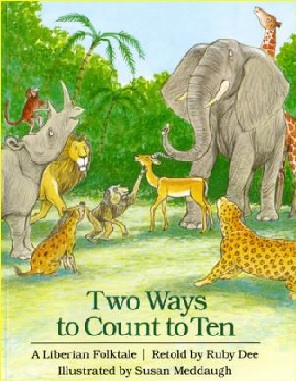
I remember reading the book to a class of fifth graders, the same grade as Jonah’s. This was quite a while ago but I remember the lesson. After talking about the ways we can count to 10―by 1s, 2s, and 5s―we talked about how to count to other numbers. We agreed on several ideas: You could count to any number by 1s, you could count to any even number by 2s, you could count to any number that ends in a zero by 10s, you could count to any number that ends in zero or 5 by 5s. This was low-hanging mathematical fruit.
I then said, “I’m thinking about the number 100. Do you agree that we can count by 1s, 2s, 5s, and 10s and land on 100?”
There was agreement about this.
Then I asked, “What about if we counted by 3s? Would we land on 100?”
What I expected was that they’d either know without having to figure, since 100 is a common benchmark number, or would easily figure out that you couldn’t. What I wasn’t prepared for was that almost all of the students didn’t know without having to figure, most hadn’t ever thought about this, and it was tough for them to reason. Since then, in many other classes, I’ve found that it’s not immediately obvious to students that you won’t land on 100 when counting by 3s.
Using the Video with Another Class
I often “borrow” classes at John Muir Elementary School in San Francisco to try out teaching ideas. After I had interviewed Jonah, I made this teaching plan to try with the Muir fifth graders:
- Teach a problem-solving lesson based on solving 100 ÷ 3 but in a context, presenting the problem of dividing 100 sheets of Origami paper equally among three classes. (This was to prepare them to listen to Jonah’s explanation.)
- Show them the video clip of Jonah solving 100 ÷ (They were familiar with being interviewed and were interested in watching me interview Jonah.)
- Give them the writing assignment of writing a letter to Jonah about whether they agreed or disagreed and to explain their thinking. (As committed as I am to conducting one-on-one interviews, I’m also committed to making writing an integral part of math instruction.)

The students were interested and curious about how Jonah thought .
My Takeaways
Here are my takeaways from the interview with Jonah, also from the experience with the fifth graders years ago when I read the book, and more recently from my experience with the fifth graders who I asked to write to Jonah:
- Takeaway #1: A general reminder to self—be cautious about the assumptions I make about what students understand and remember that students’ understanding is often fragile.
- Takeaway #2: Another reminder—partial understanding and confusion are part of the process of learning.
- Takeaway #3: And one more reminder—sure to use wait time in classroom instruction as well as during interviews.
- Takeaway #4: I always look for what students do know. Here, Jonah knew, with confidence, that 4 fourths is equal to 1 and that 33 + 33 + 33 equals 99.
- Takeaway #5: Showing video clips like these can give students experience with creating viable arguments and critiquing the reasoning of others, an important Mathematics Practice Standard.
- Takeaway #6: From the students’ letters (see below), writing is another way for me to gain valuable insights into students’ reasoning. (If you’re interested, I wrote Writing in Math Class a while ago.)
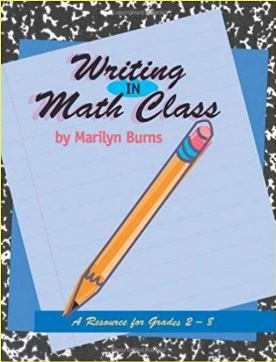
Letters the Students Wrote to Jonah
Below are some of the students’ letters. I loved reading how they explained their thinking and also how kind they were in their comments.
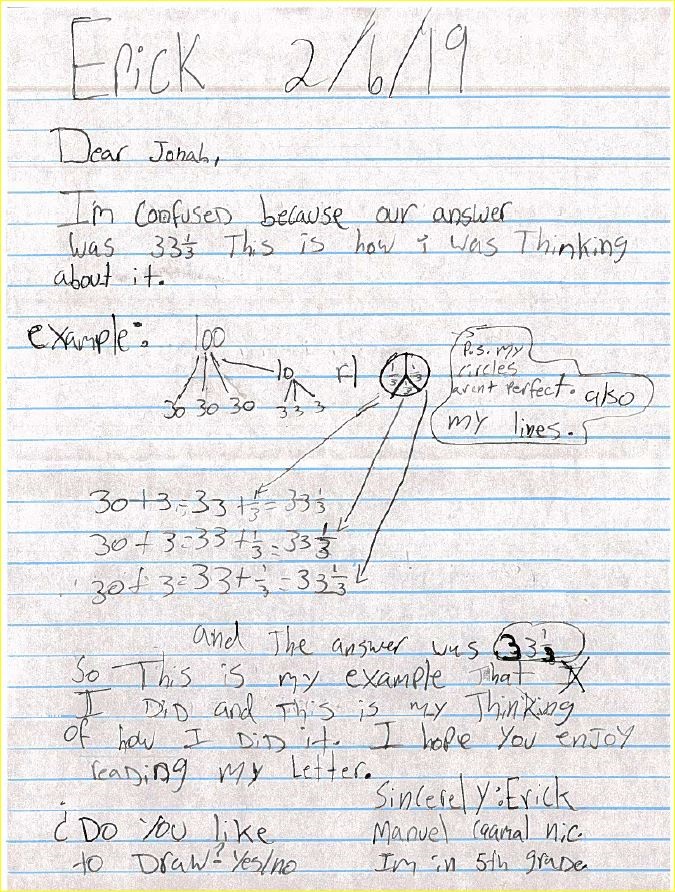
Erick showed how he split the numbers and also included a drawing.
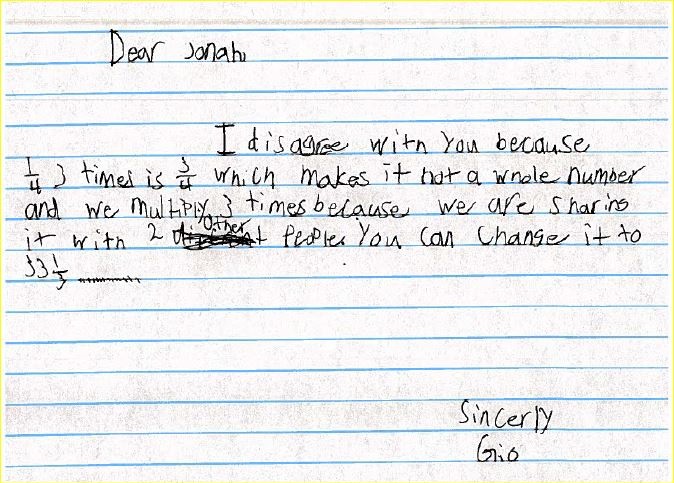
Gio’s letter is clear and succinct.

Melody gave Jonah encouragement at the end of her letter.
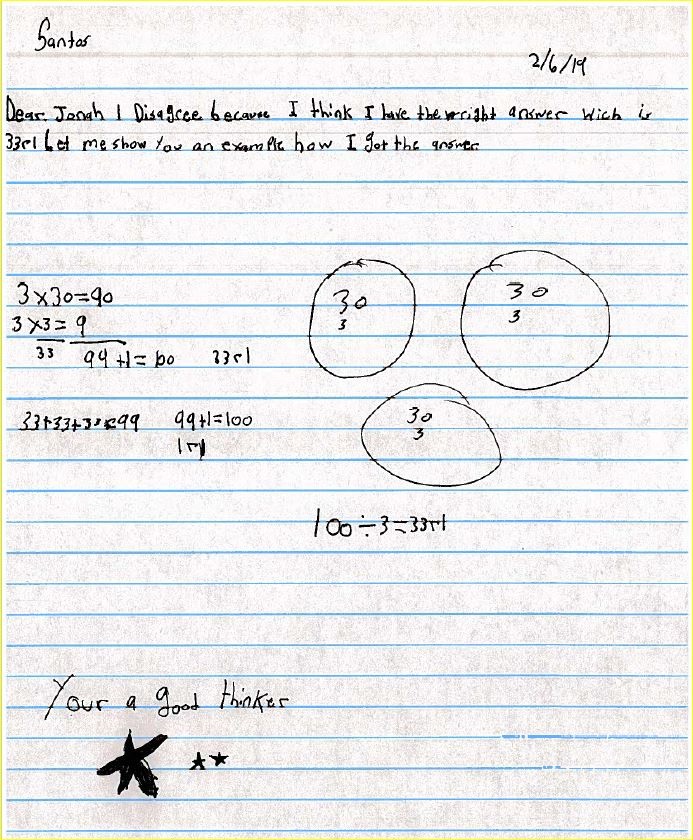
Santos used multiplication to solve the problem. He also gave Jonah encouragement at the end.

Lamberto explained how he interpreted Jonah’s error.
About Interviewing Students
The problem I asked Jonah to solve is included in one of the ten interviews from Listening to Learn, a K–5 digital interview tool that I’ve created with my colleague Lynne Zolli to help teachers conduct one-on-one math interviews with students. Along with the interviews to help teachers learn how their students reason, Listening to Learn generates reports for guiding instruction, includes an extensive video library (of more than 200 videos), and provides What’s Next? instructional suggestions. Fo another blog that describes using a video clip with students, check out What Was Nathan Thinking?

